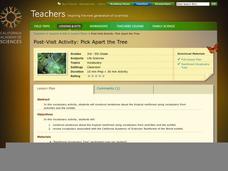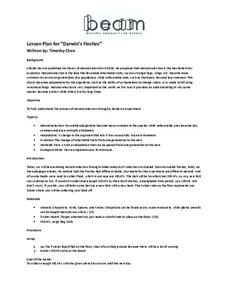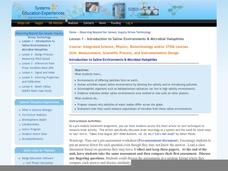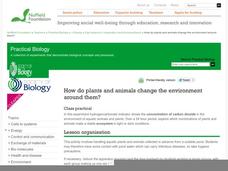Scholastic
Study Jams! The Senses: Smelling
It makes sense to sniff out a good lesson on the sense of smell. Here is a six-slide presentation that can be a strong component to that lesson! With photographs and expository graphics, life scientists find that smell is the detection...
Irish Osteoporosis Society
Osteoporosis
Osteoporosis has long been viewed as an "old ladies' disease," but there are many people at risk. There are also many things young people can do to reduce their risk factors. Learn about all of this and more through a comprehensive...
California Academy of Science
Pick Apart the Tree
In only 30 minutes, your class will have increased their rainforest vocabulary. They visualize the things they have seen on a recent trip to a rainforest exhibit. Then, they create sentences for each of the rainforest-related vocabulary...
Berkeley Engineering and Mentors
Darwin's Finches
Try a twist on the old finch beak and chopsticks activity by using M&Ms on a Twister mat. Spoons, knives, forks, and chopsticks represent beaks and are randomly assigned to your little birds, who must collect as much food as possible...
McGraw Hill
Chapter 21: Mammals
Although the worksheet found here is designed to accompany a particular textbook reading, it is a good basic review or study guide when learning about mammals. If you have a text that covers these concepts, young scientists can use the...
Science Days
My Fingerprints
Here is a very simple worksheet that offers learners the opportunity to put their fingerprints on two blackline shapes of hands. A great tool to use when teaching little ones about their unique and individual prints. Tip: Have learners...
Curated OER
Plant Structure and Function
With a few minor formatting changes, the plant parts and processes resource here would make a great study guide, quiz, or self assessment. Currently, it is a bit confusing, but changing some lettering to numbering would clear up any...
Curated OER
Breathing
When learning about the respiratory system, how do learners know what is important? One way is to use a self-assessment or study like the one found here. While the formatting could use some work, the concepts are solid. Depending on your...
Institute for Systems Biology
Introduction to Saline Environments & Microbial Halophiles
If you do not mind wading through unrelated headings (This is not for a physics or STEM course, as it states.) and content (The lesson opens with an article about neurology, not halophiles.), then you will find a valuable resource on...
Curated OER
Ecosystems
With a variety of multiple choice and short answer questions, the handout found here could be used in many ways in the classroom: pretest/posttest, study guide, reading guide, or entry/exit questions. There is not a lot of space for...
Curated OER
Celery Lab
How do sugar and salt affect celery's mass, width, and flexibility? Using simple household ingredients, young scientists will perform a controlled experiment to find out. The lab is scaffolded through a worksheet, but there are no other...
American Heart Association
Label the Heart's Parts
When learning about coronary anatomy, it is helpful to have a diagram. Here is a simple illustration of the heart ready to be labeled with the words at the bottom of the page. It could be used as a quiz, homework assignment, or completed...
Nuffield Foundation
Modelling the Human Ventilation System
Why is breathing so difficult for asthma sufferers? To find out, learners build their own lung models in the investigation (from a British website, hence the term ventilation system instead of respiratory system). Using different-sized...
Curated OER
Testing Leaves for Starch: the Technique
Like good scientists, kids often want to see first-hand why things are as they are; they can do just that in the starch-testing photosynthesis activity found here. Depending on the age of your pupils, you may wish to do the investigation...
Curated OER
How Do Plants and Animals Change the Environment Around Them?
If you have elodea and snails in your classroom aquarium, or if you have access to a pond with these organisms, your young biologists can set up a controlled experiment to determine how certain ecosystems respond in light and dark...
Nuffield Foundation
Biodiversity in Your Backyard!
Take your enthusiastic ecologists outdoors to explore the biodiversity right in their own schoolyard! In preparing for this activity, it may be worthwhile to research websites with local flora to help in the plant identification portion.
WK Kellogg Biological Station
Plotting Phenology
Finally, a worksheet that involves more than filling in some blanks. Your budding ecologists must graph and analyze three sets of data, then synthesize the information as they think about the impacts of plant reproduction on insects and...
Perkins School for the Blind
Chromosome Models- Karyotyping
Create your own karyotypes with clay in a kinesthetic genome activity. This tactile experience was created for visually impaired pupils, but can be used for all hands-on learners who are beginning to study chromosomes. The preparation...
Oregon Museum of Science and Industry (OMSI)
DNA Extraction
What does your DNA actually look like? Use simple materials with this experiment to find out! Geneticists of all ages can follow these instructions to extract their own DNA. For learners who are hoping to extend the activity, there are...
Curated OER
What Should You Know about Classification?
Many learners have a tough time picking out pertinent information from a text or in class. Sometimes, all it takes is a study/reading guide to show them the way. The learning exercise here focuses on taxonomy and classification,...
Curated OER
Classification Number Two
A three-page quiz assessing budding biologists' understanding of classification. Middle-level learners may need a little additional time on this, but should be able to handle the concepts with ease.
US Fish and Wildlife Service
Endangered Species
This handout goes along with the slide show linked at the top of the of the resource. Depending on the computer availability in your school, this could be a WebQuest in which learners go through the slide show at their own pace, or you...
Curated OER
Human Impact Starts with?
What kind of effects do humans have on their environment? Review key anthropogenic vocabulary with a fill-in-the-blank handout. You may wish to use this as an ongoing glossary, review before a test, or even create a crossword puzzle or...
AAAS
Wildflower Garden
Take your blooming botanists on a spring walk without activating any allergies with a wildflower WebQuest. The link to the "Spring Wildflower Walk" is broken, but the correct link is attached here. You could also try the activity in the...

























